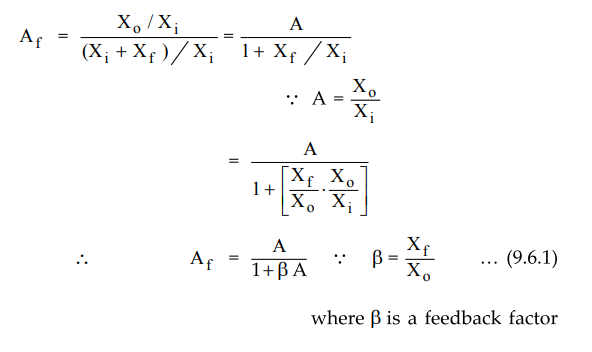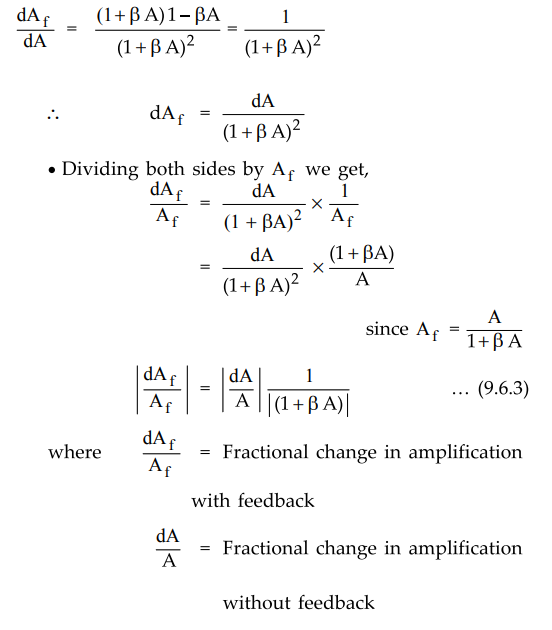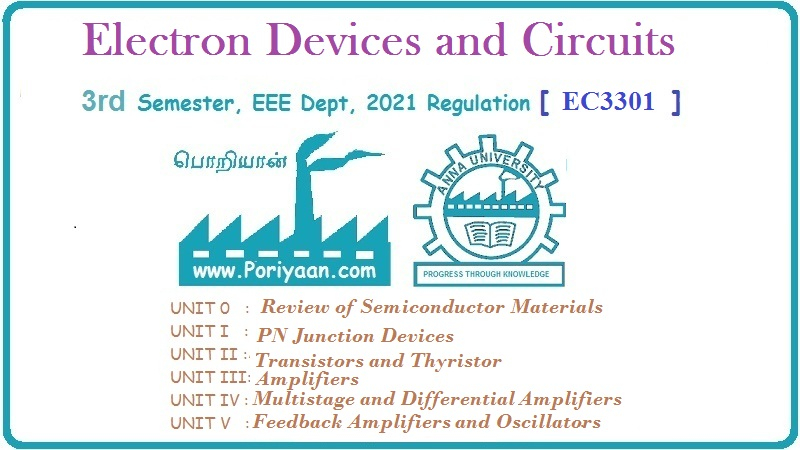Electron Devices and Circuits: Unit V: (a) Feedback Amplifiers
Gain with Feedback
Feedback Amplifiers
Looking at equation (9.6.1) we can say that gain without feedback (A) is always greater than gain with feedback [AJ(1 + β A)] and it decreases with increase in P i.e. increase in feedback factor.
Gain with Feedback
AU
: May-03, 04, 10, 11, Dec.-04, 05
•
Looking at Fig. 9.3.4 we have,
A
= Xo / Xi and Af = Xo / Xs
where Xo = Output voltage or
output current
Xi
= Input voltage or input current
Xs
= Source voltage or source current
•
As it is a negative feedback the relation between Xi and Xs is
given as
Xi
= Xs + (- Xf )
where
Xo = Feedback voltage or feedback current
Af
= Xo / Xs = Xo
/ Xi +Xf
•
Dividing by Xi to numerator and denominator we get,

Important
Concept
Looking
at equation (9.6.1) we can say that gain without feedback (A) is always greater
than gain with feedback [AJ(1 + β A)] and it decreases with increase in P i.e.
increase in feedback factor.
•
For voltage amplifier, gain with negative feedback is given as
Avf
= Av / 1 + Av β ...
(9.6.2)
where Av = Open loop gain i.e.
gain without feedback
β
= Feedback factor
1. Loop Gain
•
The difference signal, Xd in Fig. 9.3.4 is multiplied by A in passing through
the amplifier, is multiplied by P in transmission through the feedback network,
and is multiplied by β in the mixing or difference network. A path of a signal
from input terminals through basic amplifier, through the feedback network and
back to the input terminals forms a loop. The gain of this loop is the product
-A β.
This gain is known as loop gain or return ratio.
2. Desensitivity of Gain
•
The transfer gain of the amplifier is not constant as it depends on the factors
such as operating point, temperature, etc. This lack of stability in amplifiers
can be reduced by introducing negative feedback.
We
know that, Af = A / 1 + β A
•
Differentiating both sides with respect to A we get,

•
Looking at equation (9.6.3) we can say that change in the gain with feedback is
less than the change in gain without feedback by factor (1 + β A). The
fractional change in amplification with feedback divided by the fractional
change without feedback is called the sensitivity of the transfer gain. Hence the
sensitivity is (1 + β A). The reciprocal of the sensitivity is called the
desensitivity D. It is given as
D
= 1 + β A
•
The amount of feedback introduced into an amplifier is often expressed in
decibels by the definition.
N
= dB of feedback = 20 log | Avf / Av |
=
20 log | 1 / 1 + Aβ | …
•
If negative feedback is under consideration, N will be a negative number.
•
Therefore, stability of the amplifier increases with increase in desensitivity.
•
If β A >> 1, then
Af
= A / a + β A = A / β A = 1 / β ... (9.6.4)
and
the gain is dependent only on the feedback network.
•
Since A represents either Av, GM, AI or RM
and Af represents the corresponding transfer gains with feedback
either Avf, GMf, AIf or RMf the equation
signifies that :
•
For voltage series feedback :
Avf
= 1 / β voltage gain is stabilized ... (9.6.5)
•
For current series feedback :
AMF
= 1 / β transconductance gain is stabilized ... (9.6.6)
•
For voltage shunt feedback :
RMF
= 1 / β transconductance gain is stabilized … (9.6.7)
•
For current shunt feedback :
AIf
= 1 / β current gain is stabilized … (9.6.8)
Review Questions
1. W/zflf are the effects of negative feedback on gain of an
amplifier ?
AU : ECE : May-03, Dec.-OS, Marks 2
2. Derive expressions for the closed loop forward transfer ratio
for negative feedback.
AU : ECE : Dec.-04, Marks 6
3. Define loop gain.
4. What is 'return ratio' of a feedback amplifier ?
AU : ECE : May-11, Marks 2
5. Define ’desensitivity’ of transfer gain.
AU : ECE : May-04, Marks 2
6. Define sensitivity and desensitivity of gain in feedback
amplifiers.
AU : ECE : May-10, Marks 2
Electron Devices and Circuits: Unit V: (a) Feedback Amplifiers : Tag: : Feedback Amplifiers - Gain with Feedback
Related Topics
Related Subjects
Electron Devices and Circuits
EC3301 3rd Semester EEE Dept | 2021 Regulation | 3rd Semester EEE Dept 2021 Regulation
